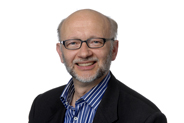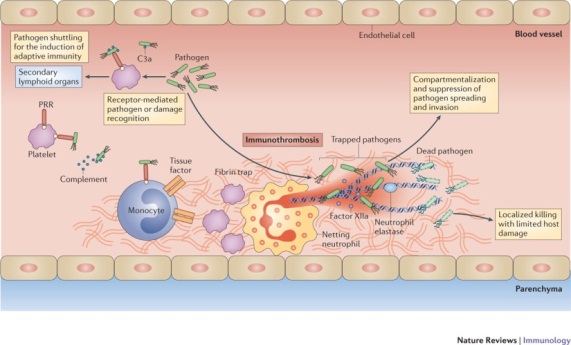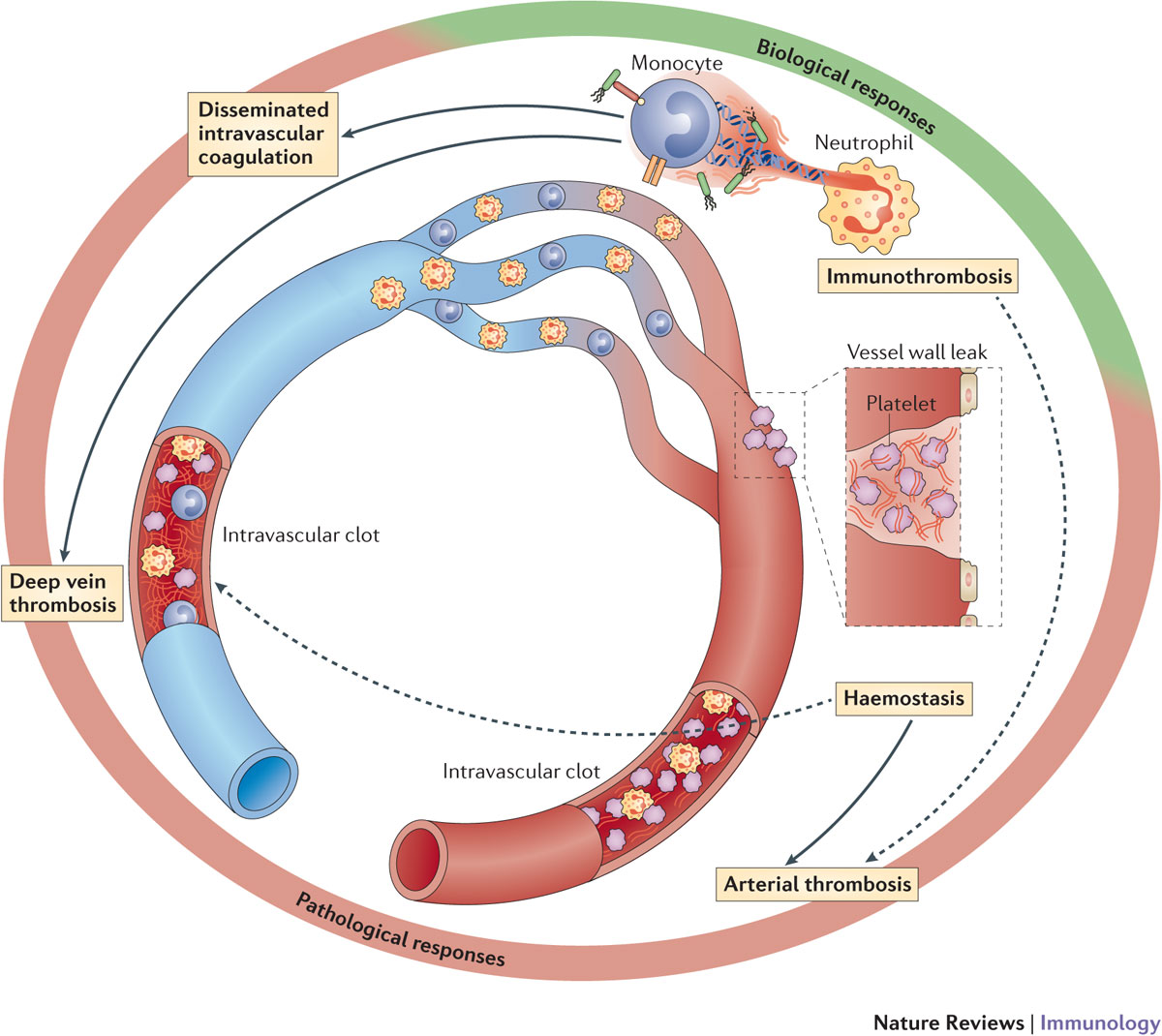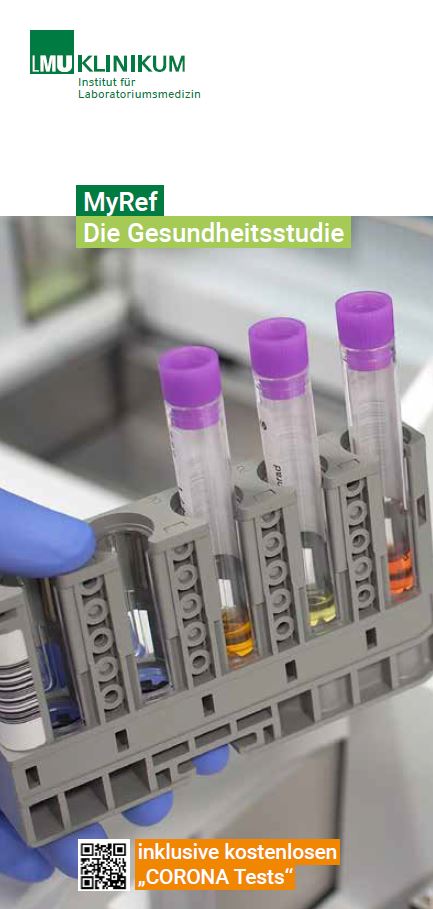Vaskuläre Biologie und Pathologie
Prof. Dr. med. Bernd Engelmann


B. Engelmann and S. Massberg. Nat Rev Immunol. 13: 34-45 (2013)
Intravaskuläre Immunität und biologische Basis vaskulärer Erkrankungen
Unsere Gruppe erforscht Immunreaktionen innerhalb von Blutgefässen (intravaskuläre Immunität). Wir haben unlängst entdeckt, dass Säugetiere eine physiologische Form der Thrombose entwickelt haben, die Immunothrombose. Die Immunothrombose hemmt die Disseminierung und Gewebeinvasion von Bakterien und fördert die Bakterienelimination bei systemischen Infektionen. Sie stellt offensichtlich eine biologische Matrize für pathologische Thrombosen dar.
Wir haben Mediatoren der angeborenen Immunität wie Neutrophile, extrazelluläre Nukleosomen, v.a als neutrophil extracellular traps (NETs), und thrombosespezifische Moleküle wie den intravaskulären Tissue Factor (TF) als wichtige Vermittler der Immunothrombose und von pathologischen Thrombosen identifiziert.
Unsere Ergebnisse zeigen, dass Protein Disulfid Isomerase (PDI) den Startmechanismus der Blutgerinnung reguliert and als Gefahrensignal wirkt. PDI aktiviert TF in Mikrovesikeln (Mikropartikeln) und verstärkt die Thrombozytenaktivierung. Die TF-induzierte Fibrinbildung wird auch durch die Freisetzung von Neutrophiler Elastase gesteuert, welche die Proteolyse und damit Inaktivierung von Antikoagulantien wie dem Tissue Factor Pathway Inhibitor vermittelt.
Die Identifizierung der biologischen Grundlagen vaskulärer Erkrankungen ist wichtig für die Entwicklung neuer diagnostischer und therapeutischer Prinzipien zur Verhinderung von pathologischen Thrombosen, die weltweit die häufigste Todesursache darstellen, da sie direkt für Herzinfarkte, Schlaganfälle und venöse Thromboembolien verantwortlich sind. Dabei könnten Thrombose-spezifische Moleküle als Zielstrukturen für neue antithrombotische Medikamente dienen, die keine Blutungskomplikationen aufzuweisen und damit gegenüber den bisherigen Therapien einen entscheidenden Vorteil besitzen.

Arbeitsgruppe:
 |
Prof. Dr. med. Bernd Engelmann |
+49 89 4400-73243 |
|
Esra Büyüközkan, scholar |
+49 89 4400-77729 |
|
|
Raphael Denz |
+49 89 4400-77729 |
|
 |
Urjita Joshi, M.Sc. |
+49 89 4400-77729 |
|
Tonina Müller |
+49 89 4400-77725 |
|
 |
Manovriti Thakur, M.Sc. |
+49 89 4400-77729 |
|
Pia Vornewald, B.Sc. |
+49 89 4400-77725 |
|
|
Xiaopeng Zhang, scholar |
+49 89 4400-77725 |
Ausgewählte Publikationen:
B. Engelmann and S. Massberg (2013).
Thrombosis as an intravascular effector of innate immunity.
Nat Rev Immunol. 13: 34-45.
M.L. von Brühl, K. Stark, A. Steinhart, S. Chandraratne, I. Konrad, M. Lorenz, A. Khandoga, A. Tirniceriu, R. Coletti, M. Köllnberger, R.A. Byrne, I. Laitinen, A. Walch, A. Brill, S. Pfeiler, D. Manukyan, S. Braun, P. Lange, J. Riegger, J. Ware, A. Eckart, S. Haidari, M. Rudelius, C. Schulz, K. Echtler, V. Brinkmann, M. Schwaiger, K.T. Preissner, D.D. Wagner, N. Mackman, B. Engelmann, S. Massberg (2012).Monocytes, neutrophils, and platelets cooperate to initiate and propagate venous thrombosis in mice in vivo.
J Exp Med. 209: 819-35.
Highlighted in:
Nature 485: doi:10.1038/485009e (2012)
S. Massberg, L. Grahl, M.-L. von Bruehl, D. Manukyan, S. Pfeiler, C. Goosmann, V. Brinkmann, M. Lorenz, K. Bidzhekov, A.B. Khandagale, I. Konrad, E. Kennerknecht, K. Reges, S. Holdenrieder, S. Braun, C. Reinhardt, M. Spannagl, K.T. Preissner, B. Engelmann (2010).
Reciprocal coupling of coagulation and innate immunity via neutrophil serine proteases.
Nat Med. 16: 887-897.
Highlighted in:
Nat. Med. 16: 851–852 (2010)
Nat. Rev. Immunol. 10: 614 (2010)
C. Reinhardt, M.-L. v. Brühl, D. Manukyan, L. Grahl, M. Lorenz, B. Altmann, S. Dlugai, S. Hess, I. Konrad, L. Orschiedt, N. Mackman, L. Ruddock, S. Massberg, B. Engelmann (2008).
Protein disulfide isomerase acts as an injury response signal that enhances fibrin generation via tissue factor activation.
J Clin Invest. 118: 1110-1122.
C. Moosbauer, E. Morgenstern, S.L. Cuvelier, D. Manukyan, K. Bidzhekov, S. Albrecht, P. Lohse, K.D. Patel, B. Engelmann (2007). Eosinophils are a major intravascular location for tissue factor storage and exposure.
Blood. 109: 995-1002.
P. Baumgärtner, M. Geiger, S. Zieseniss, J. Malleier, J.A. Huntington, K. Hochrainer, E. Bielek, M. Stoeckelhuber, K. Lauber, D. Scherfeld, P. Schwille, K. Wäldele, K. Beyer, B. Engelmann (2007). Phosphatidylethanolamine critically supports internalization of cell-penetrating protein C inhibitor.
J Cell Biol. 179: 793-804.
I. Müller, A. Klocke, M. Alex, M. Kotzsch, T. Luther, E. Morgenstern, S. Zieseniss, S. Zahler, K. Preissner, B. Engelmann (2003). Intravascular tissue factor initiates coagulation via circulating microvesicles and platelets.
FASEB J. 17: 476-8.
Curriculum vitae
Bernd Engelmann
Freie Universität Berlin, Promotion, 1986
Physiologisches Institut, Ludwig-Maximilians-Universität, München, wiss. Assistent, 1984 - 1988
Department of Biochemistry, University of Utrecht, The Netherlands, Postdoktorand, 1988 - 1989
Zellphysiologie, Ludwig-Maximilians-Universität, Habilitation, 1993
Physiologisches Institut, Ludwig-Maximilians-Universität, Priv.-Doz. und Professor, 1989 - 2002
Leiter Vaskuläre Biologie und Pathologie, Institut für Laboratoriumsmedizin, Ludwig-Maximilians-Universität, seit 2002
Neuere Auszeichnungen
Martin-Villar Haemostasis Award, First Prize, 2011 (zusammen mit S. Massberg)
Alexander-Schmidt-Preis, Gesellschaft für Thrombose- und Hämostaseforschung, 2009
Bernd Engelmann, M.D., Ph.D.


B. Engelmann and S. Massberg. Nat Rev Immunol. 13: 34-45 (2013)
Intravascular immunity and biological basis of vascular diseases
Our group studies immune responses inside blood vessels (intravascular immunity). Our recent work suggests that mammalian organisms have evolved a physiological form of thrombosis, termed immunothrombosis. Immunothrombosis prevents the dissemination and tissue invasion of bacteria and supports the bacterial killing during systemic infections. It most likely serves as a biological template mechanism for pathological thrombosis.
We have identified innate immune cells such as blood neutrophils, externalized nucleosomes, especially in the form of neutrophil extracellular traps (NETs), and thrombosis-specific molecules such as intravascular tissue factor (TF), the initiator protein of blood coagulation, as major mediators of immunothrombosis and pathological thrombosis.
Our findings show that protein disulfide isomerase (PDI) acts as an initiator of blood coagulation and injury response (danger) signal. PDI mediates activation of TF as for example expressed on microvesicles (microparticles), besides promoting activation of platelets. TF-initiated blood coagulation can also be activated by release of neutrophil elastase which cleaves and hence inactivates anticoagulant molecules such as tissue factor pathway inhibitor.
Understanding the biological basis of thrombosis is of major importance for the development of new diagnostic and therapeutic tools to combat pathological thrombosis, the most frequent cause of mortality worldwide by inducing myocardial infarction, stroke and pulmonary embolism. In particular, thrombosis-specific mediators could be targets for new anti-thrombotic interventions that lack bleeding complications, a side effect common to all known antithrombotic therapies.

Team:
 |
Bernd Engelmann, M.D., Ph.D. |
+49 89 4400-73243 |
|
Esra Büyüközkan, scholar |
+49 89 4400-77729 |
|
|
Raphael Denz |
+49 89 4400-77729 |
|
 |
Urjita Joshi, M.Sc. |
+49 89 4400-77729 |
|
Tonina Müller |
+49 89 4400-77725 |
|
 |
Manovriti Thakur, M.Sc. |
+49 89 4400-77729 |
|
Pia Vornewald, B.Sc. |
+49 89 4400-77725 |
|
|
Xiaopeng Zhang, scholar |
+49 89 4400-77725 |
Selected publications
B. Engelmann and S. Massberg (2013).
Thrombosis as an intravascular effector of innate immunity.
Nat Rev Immunol. 13: 34-45.
M.L. von Brühl, K. Stark, A. Steinhart, S. Chandraratne, I. Konrad, M. Lorenz, A. Khandoga, A. Tirniceriu, R. Coletti, M. Köllnberger, R.A. Byrne, I. Laitinen, A. Walch, A. Brill, S. Pfeiler, D. Manukyan, S. Braun, P. Lange, J. Riegger, J. Ware, A. Eckart, S. Haidari, M. Rudelius, C. Schulz, K. Echtler, V. Brinkmann, M. Schwaiger, K.T. Preissner, D.D. Wagner, N. Mackman, B. Engelmann, S. Massberg (2012).Monocytes, neutrophils, and platelets cooperate to initiate and propagate venous thrombosis in mice in vivo.
J Exp Med. 209: 819-35.
Highlighted in:
Nature 485: doi:10.1038/485009e (2012)
S. Massberg, L. Grahl, M.-L. von Bruehl, D. Manukyan, S. Pfeiler, C. Goosmann, V. Brinkmann, M. Lorenz, K. Bidzhekov, A.B. Khandagale, I. Konrad, E. Kennerknecht, K. Reges, S. Holdenrieder, S. Braun, C. Reinhardt, M. Spannagl, K.T. Preissner, B. Engelmann (2010).
Reciprocal coupling of coagulation and innate immunity via neutrophil serine proteases.
Nat Med. 16: 887-897.
Highlighted in:
Nat. Med. 16: 851–852 (2010)
Nat. Rev. Immunol. 10: 614 (2010)
C. Reinhardt, M.-L. v. Brühl, D. Manukyan, L. Grahl, M. Lorenz, B. Altmann, S. Dlugai, S. Hess, I. Konrad, L. Orschiedt, N. Mackman, L. Ruddock, S. Massberg, B. Engelmann (2008).
Protein disulfide isomerase acts as an injury response signal that enhances fibrin generation via tissue factor activation.
J Clin Invest. 118: 1110-1122.
C. Moosbauer, E. Morgenstern, S.L. Cuvelier, D. Manukyan, K. Bidzhekov, S. Albrecht, P. Lohse, K.D. Patel, B. Engelmann (2007). Eosinophils are a major intravascular location for tissue factor storage and exposure.
Blood. 109: 995-1002.
P. Baumgärtner, M. Geiger, S. Zieseniss, J. Malleier, J.A. Huntington, K. Hochrainer, E. Bielek, M. Stoeckelhuber, K. Lauber, D. Scherfeld, P. Schwille, K. Wäldele, K. Beyer, B. Engelmann (2007). Phosphatidylethanolamine critically supports internalization of cell-penetrating protein C inhibitor.
J Cell Biol. 179: 793-804.
I. Müller, A. Klocke, M. Alex, M. Kotzsch, T. Luther, E. Morgenstern, S. Zieseniss, S. Zahler, K. Preissner, B. Engelmann (2003). Intravascular tissue factor initiates coagulation via circulating microvesicles and platelets.
FASEB J. 17: 476-8.
Curriculum vitae
Bernd Engelmann
Martin-Villar Haemostasis Award, First Prize, 2011 (together with S. Massberg)
Alexander-Schmidt-Prize, Society for Research on Thrombosis and Haemostasis (GTH), 2009
Head of Vascular Biology and Disease lab, Institute of Laboratory Medicine, Ludwig-Maximilians-Universität, since 2002
Editor, Thrombosis and Haemostasis, since 2002
Editor, Biochemical Journal, 1999 - 2008
Department of Physiology, Ludwig-Maximilians-Universität, Assistant and Associate Professor, 1989 - 2002
Cell Physiology, Ph.D. (Habilitation), 1993
Department of Physiology, Ludwig-Maximilians-Universität, Munich, Germany, Scientific Assistant, 1984 - 1988
Department of Biochemistry, University of Utrecht, The Netherlands, Postdoc, 1988 - 1989
Free University of Berlin, Germany, M.D., 1986

